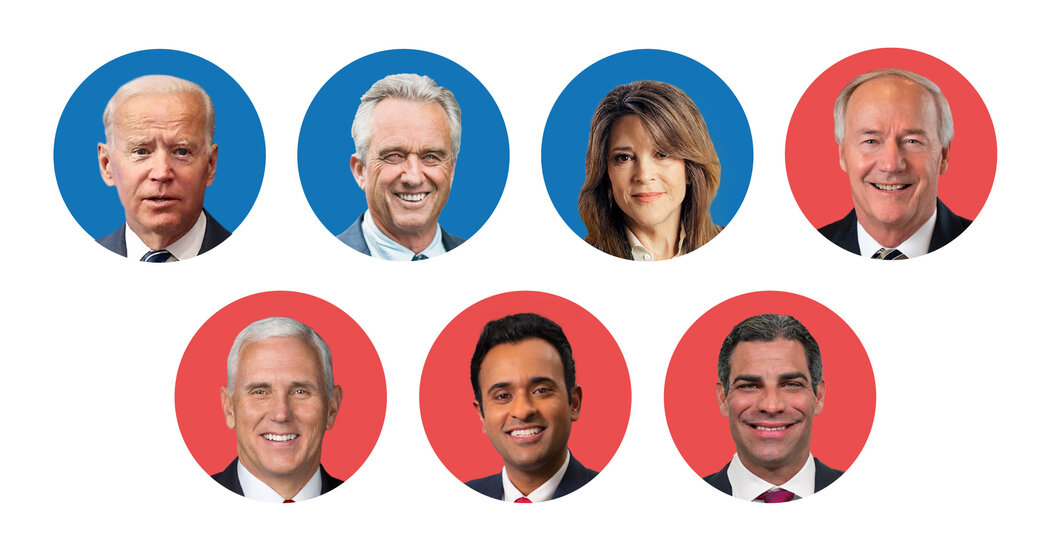On the Arizona Border, Even a Slow Day Is Busy
Helen Ramajo, 11 years old, reached the U.S.-Mexico border before the American presidents did.
As President Biden and former President Donald J. Trump prepared for the political stagecraft of dueling visits to two Texas border towns, Helen slipped through a gap in the wall in southern Arizona on Tuesday morning, her fuzzy bear-eared hoodie pulled up against the chill.
“A dream!” she said. She, her father and older sister left Guatemala a month ago, and they now trudged toward a makeshift camp with other tired, dehydrated migrants to wait beside the wall to surrender to U.S. immigration authorities.
Illegal crossings across the Southern border have plummeted in the last month, but even a slow day means dozens of migrants arriving every few hours, a ritual that has come to define life in border towns and nearby cities. Migrant aid workers say they often see around 200 people a day crossing in this area of the border outside the tiny town of Sasabe, southwest of Tucson.
A visit from two presidential candidates seeking to persuade voters they can tackle the border crisis may check an election-year box. But in this corner of southern Arizona, which now has the most undocumented crossings of any stretch of the entire Southern border, ranchers, aid workers and other residents who live and breathe the border crisis said the problem had become too intractable and complicated for any politician to tackle.
“I have no faith that it will ever be solved,” said Lori Lindsay, a cattle rancher whose Tres Bellotas ranch runs along a slice of the border wall.
The surge in illegal crossings has become a threat to Mr. Biden’s re-election hopes and a political attack line for Mr. Trump. There were 2.4 million migrant apprehensions along the Southern border in the last fiscal year, the third record-breaking year in a row.
As dozens of migrants threaded their way along the border wall on Tuesday, several said they had not been deterred by renewed construction to fill in gaps along the 30-foot-tall border wall, or by the threat of tough new enforcement measures from Washington.
The camp on the Arizona side where Helen and her family waited has sprouted up on one corner of Ms. Lindsay’s ranch, built with tents and tarps supplied by local aid groups. Ms. Lindsay said that she worried about the campfires that migrants light to stay warm, but that she had never felt threatened by any of the arriving migrants as they changed their shoes and clothes, cooked bowls of ramen and waited to be picked up by Border Patrol.
Ms. Lindsay said that the reality of the humanitarian emergency unfolding outside her gates had been distorted by politicians who painted the border as a Mad Max war zone beset by cartels and drug smugglers.
“The further away from the border they are, the more in crisis they believe we are,” she said. “We’ve never one time had a gang member or cartel show up at our house, and we’re right here.”
Ms. Lindsay, who typically votes for Democrats, said she opposed the wall and did not blame Mr. Biden for the record numbers of undocumented migrants. But she said she had grown so disenchanted with Democrats on other issues that she would not vote for Mr. Biden in November.
Along the border, people’s responses to the swell of migrants often buck party identity.
Deeply conservative ranchers leave out water for people crossing illegally through the desert. Contractors building new sections of the border wall share their lunches with migrants. Left-leaning volunteers who dedicate themselves to helping migrants criticize Mr. Biden after he threatened to shut down asylum and toughened his rhetoric on border enforcement.
“He’s Trump without the noise,” Paul Nixon, a volunteer with Green Valley Samaritans, said. “Maybe it wasn’t realistic for us to have high hopes for the Biden administration. But for anyone who identifies as a humanitarian, it’s a disappointment.”
On Tuesday morning, Mr. Nixon and his wife made a two-hour trek over bumpy dirt roads to hand out water, apples and hard-boiled eggs to the migrants arriving outside Sasabe.
They groaned with disappointment when they reached the migrants’ temporary camp. There were shredded tarps, diapers and toilet paper scattered among the mesquite trees, empty food containers lying in the dirt and ditches dug into makeshift toilets.
“This is a catastrophe, it’s not sustainable,” Mr. Nixon said. “It makes me wonder why the federal government refuses to acknowledge this.”
As they gave out water, a truck rolled up carrying a Fox News crew and Art Del Cueto, vice president of the National Border Patrol Council and a leading critic of the Biden administration’s immigration policies. Mr. Del Cueto said that Mr. Biden’s planned trip to Brownsville, Texas, on Thursday was “too little, too late.”
“It’s political reasoning,” he said. “The elections are coming up. Now, the administration wants to do something. They should have been focusing on what’s happening from the start.”
Many Democrats and Republicans along the border said that they felt misunderstood and ignored by leaders in Washington. They brushed off Mr. Biden’s and Mr. Trump’s border pilgrimages as political theater — a pinhole glimpse into a global migration crisis fueled by poverty, war and climate disasters.
“They don’t know a damn thing about the border,” said Jaye Wells, the managing partner of the Rancho de la Osa dude ranch, outside Sasabe, where many guests have canceled their reservations out of worries about violence.
Mr. Wells, who describes himself as a “George Will Republican,” said that he disagreed with Mr. Trump’s rhetoric about migrant violence, but in the eight years since buying the ranch, he said he had gradually come around to supporting a border wall. Still, he said, he would never vote for Mr. Trump.
Richelle Valenzuela, who lives in a tiny rural community about 15 miles north of the border, said that more migrants were crossing her property and knocking on her door asking to charge their phones since Mr. Biden took office. She blamed the change on Mr. Biden’s efforts to undo some Trump-era immigration policies.
Ms. Valenzuela, who voted for Mr. Trump in 2020, said she likely would again. She said she felt less safe now that a nearby Border Patrol checkpoint sits unmanned and more agents are sent to process arriving migrants.
“I love the area, but it’s totally changed,” she said. “It’s a free-for-all.”
The frustration reaches beyond the border to Tucson, about 70 miles north of the border. Local governments and migrant-aid workers said they were about to run out of federal money to shelter and transport migrants once they are released by immigration processing centers.
Officials in Pima County say they spend $1 million a week to bus migrants from small rural towns to a central shelter in Tucson, where they receive food, shelter, medical care and help connecting with family. Some also get help buying tickets to reach their final destinations in New York, Chicago, Denver and other major cities that have been strained by the recent migrant surge.
County officials say the federal money will run out next month. They said they would likely have gotten more funds under a bipartisan immigration bill that Mr. Biden supported but Republicans killed. Now, local officials said they were expecting more migrants but no more assistance.
“They’re going to be released onto the streets,” said Diego Piña Lopez, the director of Casa Alitas, the main migrant shelter in Tucson, which receives about 900 to 1,200 migrants each day. “It’s not going to be a trickle. You broke the faucet completely off.”


